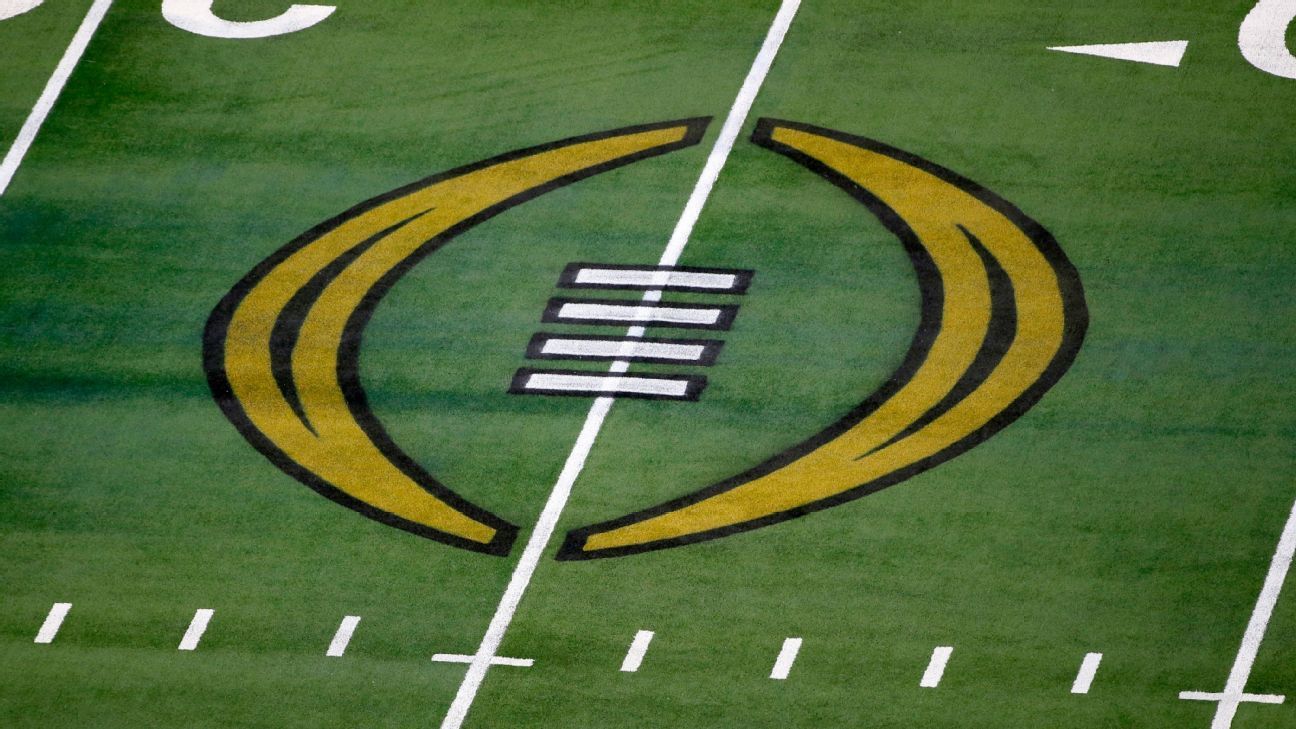
In the new 12-team

2 Related
Conference’s tiebreaker policy
Two-team tie:
1. Head-to-head
2. Win percentage against common opponents
3. Win percentage against common opponents from top-to-bottom of the conference standings (breaking ties among tied teams)
4. Combined win percentage of conference opponents
5. Higher ranking by the Team Rating Score metric (from SportSource Analytics)
6. Draw administered by the ACC commissioner
Three-plus team tie: In case of a tie for both conference championship spots, once the tiebreaker identifies one championship game representative, it will start over with the remaining tied teams.
1. Combined head-to-head win percentage among the tied teams (if all tied teams are common opponents)
2. If all tied teams are not common opponents, if any tied team defeated each of the other tied teams
2a. If all tied teams are not common opponents, and no tied team defeated each of the other tied teams, but a tied team lost to each of the other tied teams, that team is eliminated
3. Win percentage against common opponents
4. Win percentage against common opponents from top-to-bottom of the conference standings
5. Combined win percentage of conference opponents
6. Higher ranking by the Team Rating Score metric (from SportSource Analytics)
7. Draw administered by the ACC commissioner
Conference’s tiebreaker policy
Two-team tie:
1. Head-to-head
2. Win percentage against common conference opponents
3. Win percentage against the next-highest common opponent in the conference standings; in case of tied teams in standings, use each team’s win percentage against all of those teams
4. Combined win percentage in conference games of conference opponents (strength of conference schedule)
5. Total wins over the 12-game season (only one win against teams from FCS or lower division will be counted)
6. Higher ranking by the Team Rating Score metric (from SportSource Analytics)
7. Coin toss
Three-plus team tie: In case of a tie for both conference championship spots, once the tiebreaker identifies one championship game representative, it will start over with the remaining tied teams. When reduced to two tied teams, the two-team tiebreakers will be used.
1. Combined head-to-head among tied teams (if all tied teams are common opponents)
1a. If all tied teams are not common opponents, if any tied team defeated each of the other tied teams
1b. If all tied teams are not common opponents, and no tied team defeated each of the other tied teams, but a tied team lost to each of the other tied teams, that team is eliminated
2. Win percentage against all common opponents
3. Record against next-highest common opponent in conference standings; in case of tied teams in standings, use each team’s win percentage against all of those teams
4. Combined win percentage in conference games of conference opponents (strength of conference schedule)
5. Total wins over the 12-game season (only one win against teams from FCS or lower division will be counted)
6. Higher ranking by the Team Rating Score metric (from SportSource Analytics)
7. Coin toss
Conference’s tiebreaker policy
Two-team tie:
1. Head-to-head
2. Win percentage against common conference opponents
3. Win percentage against common opponents from top-to-bottom of the conference standings (breaking ties among tied teams)
4. Combined conference win percentage of conference opponents
5. Higher ranking by the Team Rating Score metric (from SportSource Analytics)
6. Draw administered by the Big Ten commissioner
Three-plus team tie: In case of a tie for both conference championship spots, once the tiebreaker identifies one championship game representative, it will start over with the remaining tied teams. When reduced to two tied teams, the two-team tiebreakers will be used.
1. Combined head-to-head among tied teams
1a. If all tied teams are not common opponents, if any tied team defeated each of the other tied teams
2. Win percentage against all common conference opponents
3. Win percentage against common opponents from top-to-bottom of the conference standings (breaking ties among tied teams)
4. Combined conference win percentage of conference opponents
5. Higher ranking by the Team Rating Score metric (from SportSource Analytics)
6. Draw administered by the Big Ten commissioner
Conference’s tiebreaker policy
Two-team tie:
1. Head-to-head
2. Win percentage against common conference opponents
3. Win percentage against common opponents from top-to-bottom of the conference standings (breaking ties among tied teams: if a two-team tiebreaker will not break a tie, combined records against tied common opponents will be used)
4. Combined conference win percentage of conference opponents
5. Higher relative total scoring margin against all conference opponents (from SportSource Analytics)
6. Random draw
Three-plus team tie: In case of a tie for both conference championship spots, once the tiebreaker identifies one championship game representative, it will start over with the remaining tied teams.
1. Combined head-to-head among tied teams (if all tied teams are common opponents)
1a. If all tied teams are not common opponents, if any tied team defeated each of the other tied teams
1b. If all tied teams are not common opponents, and no tied team defeated each of the other tied teams, but a tied team lost to each of the other tied teams, that team is eliminated
2. Record against all common conference opponents
3. Win percentage against common opponents from top-to-bottom of the conference standings (breaking ties among tied teams; if a two-team tiebreaker will not break a tie, combined records against tied common opponents will be used)
4. Combined conference win percentage of conference opponents
5. Higher relative total scoring margin against all conference opponents (from SportSource Analytics)
6. Random draw
Conference’s tiebreaker policy
Two-team tie:
1. Head-to-head
2. If one team is ranked in the latest CFP rankings (and didn’t lose in the final weekend of the regular season)
2a. If one team is ranked in the latest CFP rankings and lost in the final weekend of the regular season, a composite average of selected metrics will be used
2b. If both teams are ranked, the higher-ranked team that didn’t lose in the final weekend of the regular season (if both lose, a composite average of metrics)
2c. If neither team is ranked in the latest CFP rankings, a composite average of selected metrics will be used
3. Win percentage against common conference opponents
4. Overall win percentage (conference and nonconference) excluding exempt games
5. Coin toss
Three-plus team tie: In case of a tie for both conference championship spots, once the tiebreaker identifies one championship game representative, it will start over with the remaining tied teams.
1. Combined head-to-head (if all teams played each other)
1a. If one tied team defeated all other tied teams
2. If the highest-ranked team in the latest CFP rankings that didn’t lose in the final weekend of the regular season
2a. If the highest-ranked team loses in final weekend of regular season, a composite average of selected metrics will be used
2b. If multiple ranked teams in the CFP rankings, the highest ranked team(s) that wins in the final weekend of the regular season
2c. If all ranked teams lose on the final weekend, a composite average of selected metrics will be used
2d. If no teams are ranked in the final CFP rankings, a composite average of selected metrics will be used
3. Win percentage against common conference opponents
4. Overall win percentage (conference and nonconference) excluding exempt games
5. Coin toss
Conference’s tiebreaker policy
Two-team tie and three-team tie:
1. Head-to-head
2. Highest CFP rankings going into the final weekend (if team wins in the final weekend)
3. Highest average ranking of four computer rankings (Connelly SP+, SportSource, ESPN SOR, KPI Rankings)
4. Highest average ranking of two computer rankings (SportSource, KPI Rankings)
5. Highest most recently published multiyear football Academic Progress Rate (if same, most recent year)
6. Draw administered by commissioner’s designee
Conference’s tiebreaker policy
Two-team tie:
1. Head-to-head
2. Win percentage against common opponents
3. Win percentage against common opponents based on MAC finish (breaking ties) from top-to-bottom of conference
4. Combined conference win percentage of conference opponents
5. Higher ranking by Team Rating Score metric (SportSource Analytics)
6. Draw administered by MAC commissioner
Three-team tie:
1. Combined head-to-head (if all teams played each other)
2. If one tied team defeated all other tied teams
3. Win percentage against all common opponents
4. Win percentage against all common opponents based on finish (with ties broken)
5. Combined conference win percentage of conference opponents
6. Higher ranking by Team Rating Score metric (SportSource Analytics)
7. Draw administered by MAC commissioner
Conference’s tiebreaker policy
Two-team tie:
1. Head-to-head
2. Highest CFP ranking (if team wins in the final weekend)
2a. If only or both CFP ranked teams loses in the final weekend (or if there is no ranked teams), an average of metrics will be used
3. Overall win percentage (conference and nonconference)
4. Record against the next-highest team in the conference standings (tied teams will be lumped together if tied teams played all those teams)
5. Win percentage against common conference opponents
6. Coin toss conducted virtually by the commissioner
Three-plus team tie:
1. Combined head-to-head (if all teams played each other)
2. If one tied team defeated all other tied teams
3. Highest CFP ranking among teams to win in the final weekend
4. Average of selected metrics (if ranked team loses or if no teams ranked)
5. Overall win percentage against all opponents (conference and nonconference); maximum one win against FCS or lower-division team
6. Record against the next-highest team in the conference standings (tied teams will be lumped together if tied teams played all those teams)
7. Win percentage against common conference opponents
8. Drawing conducted virtually by the commissioner
Conference’s tiebreaker policy
Two-team tie
1. Head-to-head
2. Overall win percentage
3. Win percentage against the next-highest team in the division standings (lumping together tied teams)
4. Win percentage against all common nondivisional conference opponents
5. Higher-ranked teams in the CFP rankings (if it wins in the final regular season week); if the highest-ranked team loses, an average of selected computer rankings (Anderson & Hester, Massey, Colley and Wolfe)
6. If no team is ranked in the CFP rankings, an average of selected computer rankings (Anderson & Hester, Massey, Colley and Wolfe)
7. Overall win percentage (conference and nonconference) against FBS teams
8. Coin toss
Three-plus team tie: (Teams will not revert to two-team tiebreaker once three-plus team tiebreaker is trimmed to two.)
1. Combined head-to-head
2. Divisional win percentage
3. Win percentage against the next-highest team in the division standings (lumping together tied teams)
4. Highest-ranked team in the CFP rankings (if they win in the final weekend of regular season); if that team loses, an average of selected computer rankings
5. If no team is ranked in the CFP rankings, an average of selected computer rankings (Anderson & Hester, Massey, Colley and Wolfe)
6. Overall win percentage (conference and nonconference) against FBS teams
7. Draw lots (conducted by commissioner)
Check out the ESPN college football hub page for the latest news, analysis, schedules, rankings and more.












